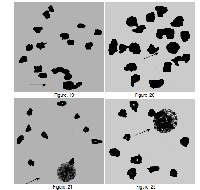Meiotic Studies in Some Medicinal Angiosperms from Doaba Region of Punjab, India
Keywords:
Chromosomes, Meiosis, Medicinal plants, Doaba region, Punjab, IndiaAbstract
The chromosome number and their behavior in 15 medicinal plant species collected from Doaba region of Punjab, India have been studied. The species have shown chromosome numbers like Basella rubra L. (n=22), Coccinia cordifolia Cogn. (n=12), Delphinium ajacis L. (n=8), Lens culinaris Medic. (n=7), Melilotus alba Desr. (n= 8), Nicotiana plumbaginifolia Viv. (n=10), Nymphoides cristata (Roxb.) Kuntze (n=9), Papaver rhoeas L. (n=7), Raphanus sativus L. (n=9), Sesamum indicum L (n=13), Tinospora cordifolia (Wild.) Hook.f.et Thoms. (n=13), Triticum aestivum L. (n=21), Vitex negundo L. (n=17), Xanthium strumarium L. (n=18) and Zea mays L. (n=10). Most of the species are diploid with normal course of meiosis. But meiotic abnormalities in the form of univalents, stickiness and presence of supernumerary B-chromosomes have also been observed in some species. All the species have some medicinal value. The chromosome counts in these species are in conformity with the earlier reports, but behavioral changes have been observed in some species. This shows the genetic stability and resistance of these species to various biotic and abiotic stresses.
References
Soltis PS, Soltis DE. The origin and diversification of Angiosperms. American Journal of Botany. 2004; 91(10): 1614-1626.
http://instruct.uwo.ca/biology/3404f/Soltis&Soltis2004.pdf
Sidhu MC, Kaur K. A meiotic study in some Medicinal Plants. Chromosome Botany. 2013; 8(2): 35-40. https://www.jstage.jst.go.jp/article/iscb/8/2/8_35/_pdf
Peter KV. Ceylon spinach, In: Genetics and Breeding of Vegetables, ICAR, Pusa, New Delhi, India. 1998; pp-31.
Bhowmick BK, Jha TB, Jha S. Chromosome analysis in the dioecious cucurbit Coccinia grandis (L.) Voigt. Chromosome Science. 2012; 15: 9-15.
https://www.jstage.jst.go.jp/article/scr/15/1%2B2/15_9/_pdf
Agelet A, Valles J. Studies on pharmaceutical ethnobotany in the region of Pallars (Pyrenees, Catalonia, Iberian Peninsula) Part-I. General results and new or very rare medicinal plants. Journal of Ethnopharmacology. 2001; 77: 57-70.
http://www.sre.urv.es/irmu/ipec/docs/pallars1.pdf
Singh RN. Chromosome association and Behaviour in Autotetraploid Delphinium ajacis L. Cytologia. 1991; 56: 479-483.
https://www.jstage.jst.go.jp/article/cytologia1929/56/3/56_3_479/_pdf
Rehman SU, Altaf CM. Karyotypic studies in the Lens culinaris Medic, S.SP. Macrosperma cv. Laird X Precoz. Pakistan Journal of Botany. 1994; 26 (2): 347-352. http://www.pakbs.org/pjbot/PDFs/26%282%29/PJB26%282%2919.pdf
Pavlova D, Tosheva A. Karyological studies of Melilotus alba Med. (Fabaceae) populations in Bulgaria. Caryologia. 2002; 55 (2): 105-110.
http://www.caryologia.unifi.it/past_volumes/55_2/Caryologia_55_2_105-110.pdf
Hijazy HY. Karyomorphological studies of some Melilotus Mill. Species in Egypt. Egyptian Journal of Biotechnology. 2006; 13: 22.
Dangwal LR, Rana CS, Sharma A. Ethnomedicinal Plants from transitional zone of Nanda Devi Biosphere Rserve, District Chamoli, Uttarakhand (India). Indian Journal of Natural Products and Resources. 2011; 2(1): 116-120.
http://nopr.niscair.res.in/bitstream/123456789/11550/1/IJNPR%202%281%29%20116-
Villa A. The chromosome idiogram of Nicotiana plumbaginifolia. Genetica. 1984; 64 (2): 145-148. http://link.springer.com/article/10.1007%2FBF00120266#page-1
Cannon GC, Van KTT, Heinhorst S, Trinh TH, Weissbach A. An examination of the plastid DNA of hypohaploid Nicotiana plumbaginifolia plants. Plant Physiology. 1989; 90: 390-393. http://www.plantphysiol.org/content/90/2/390.full.pdf
El- Nahas AI, Khalifa SF, El- Enain MMA. Karyological studies on the Solanaceae. Pakistan Journal of Biological Sciences. 2000; 3 (5): 717-720.
http://198.170.104.138/pjbs/2000/717-720.pdf
Mitra S, Mukherjee SK. Roots and Rhizome Drugs used by the Tribals of West Dinajpur in Bengal. Journal of Tropical Medicinal Plants. 2005; 6(2): 301-315.
http://www.academia.edu/867425/
Li SP, HsiehTH, Lin CC. The genus Nymphoides Seguier (Menyanthaceae) in Taiwan. Taiwania. 2002; 47 (4): 246-258.
http://tai2.ntu.edu.tw/taiwania/pdf/tai.2002.47.4.246.pdf
Tuzlaci E, Aymaz PE. Turkish folk medicinal plants, Part IV: Gonen (Balikesr). Fitoterapia. 2001; 72: 323-343.
http://www.sciencedirect.com/science/article/pii/S0367326X0000277X#
Asghari R, Razmi S, Madadi R, Fathi M. Karyological studies of the medicinal plant Papaver rhoeas from Northwest of Iran. African Journal of Biotechnology. 2011; 10 (54): 11173- 11177. http://www.ajol.info/index.php/ajb/article/view/96097
Zhang W, Zhan S, Zhang H. Pollen mother cell mitosis and male gametophyte development of Raphanus sativus L. Journal of Nanjing Agricultural University. 2007; 30: 38-41.
Ashri A. Sesame (Sesamum indicum L.). In: Singh RJ, Editor. Genetic Resources, Chromosome Engineering and Crop Improvement: Oilseed Crops, Volume 4. CRC Press; 2006. p. 231-280. http://www.sponpress.com/books/details/9781420005363/
Mathew PM. Studies on the Menispermaceae. Proceedings of the Indian Academy of Sciences. 1958; 47 (5): 24-286.
http://link.springer.com/article/10.1007%2FBF03051558?LI=true
Feldman M, Mello-Sampayo T, Sears ER. Somatic association in Triticum aestivum. Proceeding of the National Academy of Sciences. 1966; 56 (4): 1192-1199.
http://www.jstor.org/stable/57810
Jahan Q, Vahidy AA. Karyotype analysis of Hexaploid wheat, Triticum aestivum L. CV. ‘SARSABZ’. Journal of Islamic Academy of Sciences. 1989; 2(3): 179-181.
http://www.medicaljournal-as.org/belgelerim/belge/jahanwgchqafotp59596.pdf
Sandhu PS, Mann SK. SOCGI plant chromosome number reports-VII. Journal of Cytology and Genetics. 1988; 23: 219-228.
http://www.tropicos.org/Name/33700563?tab=chromosomecounts
Kathoon S, Ali SI. Chromosome Atlas of the Angiosperms of Pakistan. University of Karachi, Department of Botany; 1993.
http://www.tropicos.org/Name/33700563?tab=chromosomecounts
Arshad M, Nisar MF, Majeed A, Ismail S, Ahmad M. Ethnomedicinal flora in district Sialkot, Punjab, Pakistan. Middle- East Journal of Scientific research. 2011; 9(2): 209-214. http://www.idosi.org/mejsr/mejsr9%282%2911/12.pdf
Singhal VK, Garg P, Kumar P. Cytological studies of some Dicots from the hills of Mandi district (Himachal Pradesh) in North-West India Himalayas. Cytologia. 2013; 78 (1): 1-14. http://ugcdskpdf.unipune.ac.in/Journal/uploads/BL/BL100184-A-6.pdf
Fisk EL. The chromosomes of Zea mays. American Journal of Botany. 1927; 14(2): 53-75. http://www.jstor.org/stable/2435580



